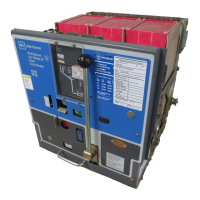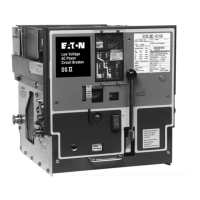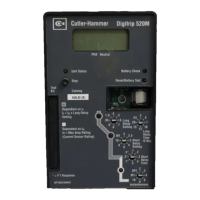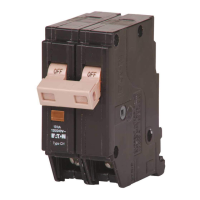1.8. 33-790-11
8.
Open-Close indicator.
9.
Spring charge indicator.
10.
The close bar and trip plate.
11.
Steel front cover.
12.
Nameplate with complete rating information.
The Type DSL-206 and DSL-416 drawout elements also
include the following components:
1.
Current limiters.
2.
Isolating transformers, connected
in
parallel with the
limiters.
3.
Combination "Blown Limiter Indicator'' and anti-single
phase device, connected to the isolating transform-
ers, actuated by blowing
of
one
or
more
of
the cur-
rent limiters. This device has individual phase
indicators and a common "RESET" button extending
through the front cover.
Each breaker is equipped with a spring-type stored
energy closing mechanism. This mechanism closes the
circuit breaker contacts with the necessary speed and
force, independently
of
the operator. Basically, the clos-
ing springs must first be charged
or
cocked before the
breaker can be closed. The springs are then released by
releasing the spring release latch. The breaker is opened
by
releasing the tripping latch.
3.1
INDEPENDENT MANUAL AND POWER-
OPERA TED BREAKERS
3.1.1 Closing Facilities
On manually operated breakers, the closing springs can
be charged only by hand, by means
of
the spring-charge
handle. The actual closing
of
the breaker is done only by
hand-push
on
the close bar. As optional equipment, the
electrical spring release attachment normally supplied
only on power-operated breakers can be supplied on
manually operated breakers.
Effective October 1998
Page
11
On power-operated breakers, the springs are normally
charged by
an
electric motor. Closing may be done elec-
trically by
an
electro-magnet which lifts the closing spring
release latch. Both
of
these operations can be done
by
hand if the control power source fails.
3.1.2 Tripping Facilities
The breaker can be tripped open by hand by pushing
with the finger on the trip plate
on
the breaker panel
or
the trip plate
on
the breaker compartment door (the latter
is operative only when the breaker is
in
the connected
position).
The breaker can also be tripped electrically by the follow-
ing devices:
1.
Shunt trip device, optional equipment on manually
operated breakers.
2.
Trip Actuator, energized from the Amptector trip unit.
3.
Undervoltage Trip Device (Optional
on
all breakers)
4.
Blown Limiter Indicator (for DSL breakers)
3.2 LEVERING DEVICE
The drawout element has four normal positions
in
its
compartment, determined by the levering device:
1.
The REMOVE position, Figure
6.
2.
The DISCONNECT position.
3.
The TEST position, Figure
7.
4.
The CONNECT position, Figure
8.
The REMOVE position is the first position
in
the compart-
ment as the element is pushed directly
by
hand as far as
it will go. The DISCONNECT, TEST, and the CONNECT
positions are reached only
by
means
of
the levering
device. This is hand operated with a removable crank
handle. This handle is placed
on
the levering device
worm shaft, which is exposed by depressing the shutter.
Courtesy of NationalSwitchgear.com

